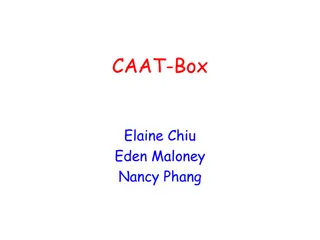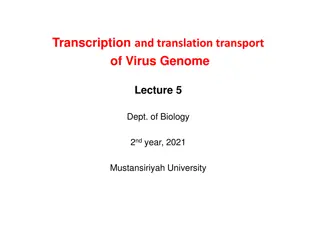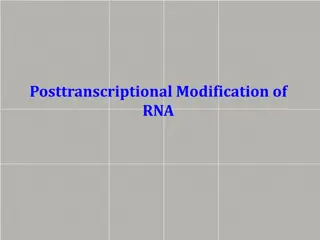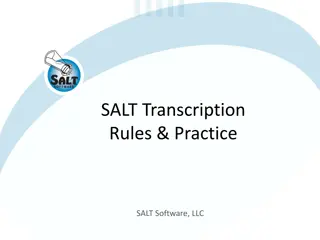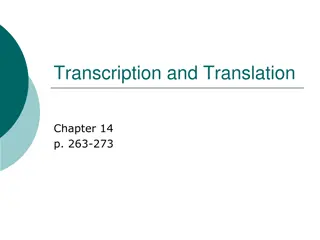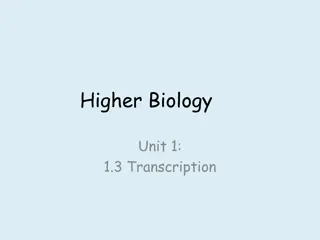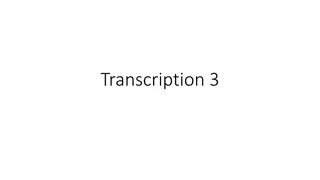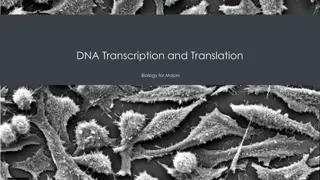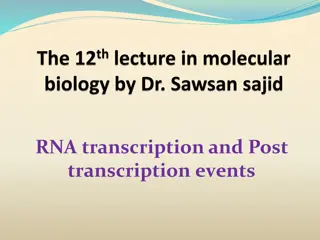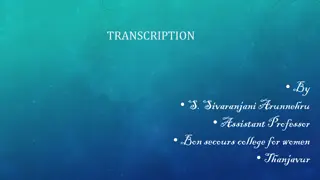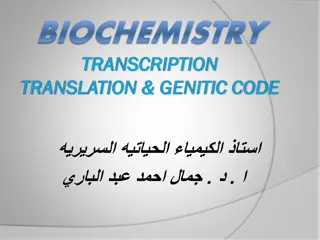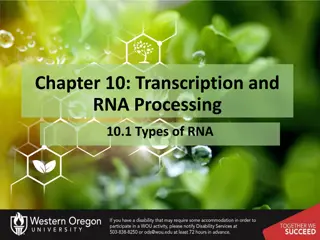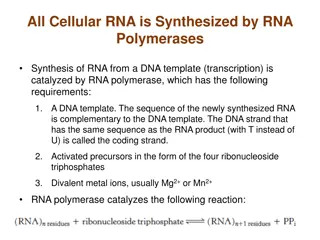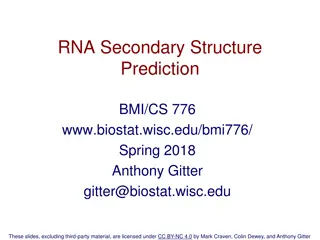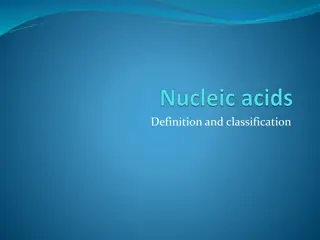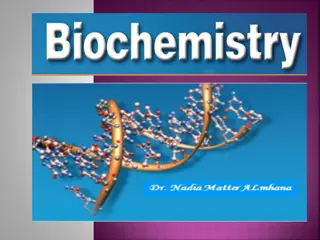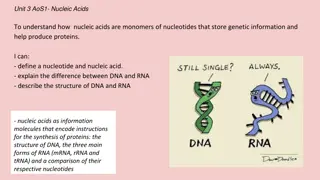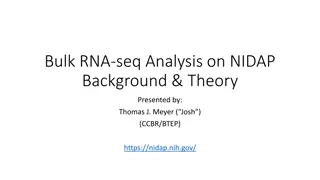Understanding DNA, RNA, and Transcription Process
The content delves into the intricacies of DNA and RNA, highlighting the significance of DNA safety in the nucleus, the role of RNA in protein synthesis, different types of RNA, the transcription process, and the importance of RNA in genetic information transfer. It also discusses how DNA is transcribed into RNA, the structure of DNA enabling easy transcription, and the significance of introns and exons in RNA processing.
Download Presentation

Please find below an Image/Link to download the presentation.
The content on the website is provided AS IS for your information and personal use only. It may not be sold, licensed, or shared on other websites without obtaining consent from the author. Download presentation by click this link. If you encounter any issues during the download, it is possible that the publisher has removed the file from their server.
E N D
Presentation Transcript
DNA Info DNA in the nucleus is safe But DNA in the cytoplasm can be destroyed
RNA Ribonucleic Acid Copy of DNA that goes into cytoplasm guides synthesis of proteins DNA 2 Strands RNA 1 Strand # of strands Type of Sugar Nucleotide Base pairs Deoxyribose sugar A-T C-G Ribose Sugar A-U C-G
3 types of RNA Messenger RNA (mRNA) complementary to DNA C=G, A=U Travel from nucleus to ribosome Direct synthesis of protein Ribosomal RNA (rRNA) forms ribosomes Transfer RNA (tRNA) brings amino acids
Transcription RNA is made from 1 strand of DNA Specifically mRNA is made DNA safe in the nucleus To send a message to the cytoplasm Uses mRNA
Transcription 1. Unzip DNA (helicase) 2. RNA Polymerase binds to synthesize RNA 3. Match up bases to one strand of DNA 1. Uracil instead of thymine 4. mRNA detaches from the DNA 5. mRNA moves out of nucleus and into cytoplasm
DNA mRNA mRNA Cytoplasm of cell Nucleus Transcription happens in the nucleus. An RNA copy of a gene is made. Then the mRNA that has been made moves out of the nucleus into the cytoplasm Once in the cytoplasm, the mRNA is used to make a protein
Transcribe DNA 1. If a DNA strand read AAC GTC GCG TAC, what would the mRNA strand be 2. Does the mRNA model more closely resemble the DNA strand from which it was transcribed or the complementary strand that wasn t used? Explain 3. Explain how the structure of DNA enables the molecule to be easily transcribed. Why is this important for genetic information? 4. Why is RNA important to the cell? How does an mRNA molecule carry information from DNA?
A little more about RNA DNA is interrupted by short sequences that are not in the final mRNA Called introns Exons = RNA kept in the final sequence
What are 3 differences between RNA and DNA Agenda for Today 1. Translation
The Code Every 3 bases codes for amino acid sequence Three base code is called a codon All but 3 codons code for an amino acid AUG = start codon
Ribosomes 2 subunits only together during translation Attaches to mRNA strand tRNA 3 base sequence at the bottom anticodon Matches the codon on mRNA strand
Translation mRNA attaches to ribosomes tRNA moves into ribosome Anticodon matches with mRNA strand and adds an amino acid tRNA leaves ribosome Stop codon is reached & amino acid chain (polypeptide) detaches from ribosome Folds and creates a protein
Proteins Shape depends on interactions among amino acids Hydrogen bonding
Translate your mRNA 1. Write your Amino Acid Sequence 2. Would you make a complete protein? Explain. 3. Transcribe and translate the following DNA sequence. Draw a line separating each codon: A T C G T C C A A
Transcribe (make RNA) and translate (find amino acids) from this strand of DNA AAA TGC ACG TCG
Whiteboard questions What does DNA polymerase do? What does Helicase do? What does ligase do? Match the bases below. 5 A T C G T A 3 List 3 differences between RNA/DNA. What are the 3 types of RNA? Where does RNA go after it is made? Transcribe the DNA below. A T C G T A
Whiteboard questions What does RNA attach to when it leaves the nucleus? Amino Acids are the building block of ________. What type of RNA brings an amino acid? When does translation stop? Where is the codon located? Anticodon? What is a codon? Translate the mRNA strand below. A G C G A G
Replication DNA Helicase unzips DNA Proteins keep it apart RNA Primase adds starter segments DNA Polymerase adds nucleotides to DNA Leading continuous adding of bases Lagging Okazaki fragments DNA Ligase fills in gaps
Transcription DNA Helicase unzips DNA RNA Polymerase adds bases Only 1 strand of DNA gets copied RNA detaches from DNA strand and moves into cytoplasm
Translation mRNA attaches to ribosomes tRNA moves into ribosome Anticodon on tRNA matches with codon on mRNA strand Amino acid is added Stop codon is reached & amino acid chain (polypeptide) detaches from ribosome Folds and creates a protein
DNA vs. RNA DNA RNA 2 Strands 1 Strand Deoxyribose sugar Ribose Sugar A-T C-G A-U C-G
Mutations Mutations: Changes that occur to the chromosomes. -These can be both good or bad. -Most Mutations are never shown. -These can occur in any cell that divides. -Mutations can eventually lead to changes in the entire population over many years.
Gene Mutations These mutations involve individual genes. -Any chemical change that affects the DNA can cause this type of mutation to happen. -Some may cause a change to 1 nucleotide, while some may change many.
Germ Mutations: Mutations that affect the reproductive cells. Somatic Mutations: These do not affect the reproductive cells. -They are not inherited. (Both can occur at the level of Chromosomal and Gene Mutations) Sex Linked Genes:
Chromosomal Mutations Change in the number or structure of chromosomes. -These are mutations that can involve the entire chromosome, on part or even pairs of chromosomes.
Four types of Chromosomal Mutations: 1. Deletion: A loss of part of the chromosome. 2. Duplication: Segment of chromosome is repeated. 3. Inversion: Part of the chromosome is orientated in reverse of its usual direction. 4.Translocation: One part of the chromosome breaks off and attaches to another chromosome



